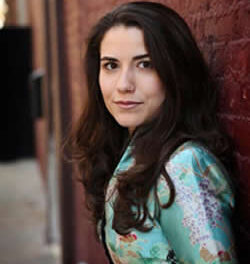Musical colors were a running thread through all the selections played on the 21st-Century Residency Concert on April 18 in Watson Chamber Music Hall at the NC School of the Arts. Four of the selections featured a broad line-up of talented faculty from the School of Music. The final piece, utilizing the largest forces, showcased the impressive virtuosity of the students in the School of the Arts Contemporary Ensemble. All these forces were under the elegant and spare baton of composer Lawrence Dillon.
Augusta Read Thomas (b.1964), this year’s resident composer, spent much of the week in sessions with students and faculty. She is winding down a stint as composer-in-residence at the Chicago Symphony Orchestra (1997-2006) and, until 2008, is the Chair of the Board of the American Music Center. She studied at Northwestern University, Yale University, and the Royal Academy of Music. An impressive array of major conductors and commissions can be found on her website, at http://www.augustareadthomas.com/. During brief comments from the stage, Thomas said she has been passionately interested in sound since the age of two and is wholly committed to composing. She is particularly focused on harmonic fields and special sound colors in performances. In addition to admiration for J.S. Bach, the work of Luciano Berio has been most important to her development as a composer. Both of her works received their North Carolina premieres at this concert. They ended each half of the program.
The most immediately appealing work was “Passion Prayers,” a Concertino for Cello, flute, clarinet, violin, harp, piano, and percussion (1999). The brilliant cello part ranges from sensuous to vehement and is played continuously. The other six musicians start playing independent snatches that gradually mirror the solo cello’s music, using a fragmentation and linkage technique similar to one pioneered by Berio. Cellist Zvi Plesser’s performance was deeply committed and intense, his intonation was flawless, his melodic line was seamless, and his tone was dark and warm. Thomas said it was a joy to hear such a satisfying performance in a fine hall.
Before the performance, I was skeptical of Thomas’s “Soliloquy of the Interior Paramour” (2004), which was receiving its second performance. According to the excellent program notes, the composer chose as her text two late poems by Wallace Stevens about his art. A mezzo-soprano and a countertenor mostly sing but occasionally speak “Final Soliloquy of the Interior Paramour” while one of the percussionists speaks “The Poem That Took The Place Of A Mountain.” Sometimes members of the large ensemble hum or vocalize “with unison singing and chanting adding to the lush orchestration.” The larger forces greatly expand the halos of color that surround the solos. Instead of the cacophony I feared, the complex juxtaposition of the strongly contrasted texts made for a fascinating combination that was immediately attractive. The very fine singers were countertenor Leif Westermark and mezzo-soprano Olivia Vote. Their precisely focused sound seemed to have a mechanical-like purity. Percussionist Jonathan Scheibler’s clear diction enabled him to project the second poem clearly. The large student ensemble played with intense professional commitment.
The “Broken Consort” (1996) of Sebastian Currier (b.1959) opened the concert. Two spatially separated guitars sandwich flute, oboe, violin, and cello. The music begins and ends with a mechanical, ordered state, surrounding a chaotic episode. The ending has a lyrical element that is absent at the beginning.
The guitarists were Gerald Klickstein and Joseph Pecoraro, with flutist Tadeu Coelho, oboist John Ellis, violinist Joseph Genualdi, and cellist Zvi Plesser.
Luciano Berio’s unusual approach to writing for the voice was clearly displayed in “O King,” for soprano, flute, clarinet, violin, cello, and piano (1968), a memorial to the then recently assassinated Martin Luther King. According to the program notes, “the voice is treated as an equal member of the ensemble, intoning first the vowels of Dr. King’s name, gradually adding the consonants, only connecting them to sing his full name in the final bars.” Soprano Marilyn Taylor used subtle control of color and dynamics to deliver the unusual vocal line. Harmonics from other instruments combined to create an eerie and mournful effect. Coelho, Genualdi, and Plesser were joined by clarinetist Igor Begelman and pianist Eric Larsen.
The “Tent of Miracles” (1984) by Martin Bresnick (b.1946) was as striking visually as it was aurally. It features a solo baritone saxophone accompanied by three pre-recorded baritone saxophones. According to the program notes, “the piece… doesn’t evoke specific events from [the Brazilian novel Tenda dos milagres by Jorge Amado] but rather reflects the spirit of the vivid, imaginative art of the people of Bahia.” With earphones covering one of his ears, Taimur Sullivan put the piece through its paces. The second movement, featuring an extended section of clicking saxophone keys, is unusual. Halfway through, Sullivan again played – but while the pre-recorded woodwinds accompanied him with their clicking keys. From time to time, Sullivan vocalized into his mouthpiece. Previously I had only seen this technique used on flute and French horn.
Edited/updated 4/24/06.











